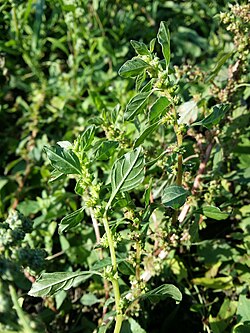Biology:Amaranthus graecizans
| Amaranthus graecizans | |
|---|---|

| |
| Scientific classification | |
| Kingdom: | Plantae |
| Clade: | Tracheophytes |
| Clade: | Angiosperms |
| Clade: | Eudicots |
| Order: | Caryophyllales |
| Family: | Amaranthaceae |
| Genus: | Amaranthus |
| Species: | A. graecizans
|
| Binomial name | |
| Amaranthus graecizans | |
Amaranthus graecizans, the Mediterranean amaranth[1] or short-tepalled pigweed,[2] is an annual species in the botanical family Amaranthaceae. It is native to Africa, southern Europe, East Asia to India and Central Asia.[3] It is naturalized in North America. More general common names include tumbleweed and pigweed.[4]
Characteristics
Amaranthus graecizans is an annual herb that grows up to 50 cm (20 in) tall. Stems are branched from base, glabrous or covered with crisped hairs. The flowers are unisexual and are yellow with round black seeds that are 1–1.25 mm.[5]
Habitat
Amaranthus graecizans grows in warm temperate zones where it can be found at elevations up to 2,400 m (7,900 ft).[6] It grows rapidly after rain and can be found in on disturbed ground in the vicinity of human and livestock settlements as well as seasonally flooded sandy flats.[7]
Uses
The edible leaves are used as a vegetable throughout Africa and the Middle East.[8] It can be eaten raw, but was more often cooked, or added to sauces and stews. A common way to cook Amaranthus graecizans was to cook it in buttermilk, or to squeeze fresh lime-juice over it.[9] The seeds are starchy and can also be eaten[10]
No members of this genus are known to be poisonous, but when grown on nitrogen-rich soils they are known to concentrate nitrates in the leaves.[citation needed] This is especially noticeable on land where nitrate fertilizer is used.
References
- ↑ "Amaranthus graecizans". Natural Resources Conservation Service PLANTS Database. USDA. https://plants.usda.gov/core/profile?symbol=AMGR13. Retrieved 7 January 2016.
- ↑ (xls) BSBI List 2007, Botanical Society of Britain and Ireland, https://bsbi.org/download/3542/, retrieved 2014-10-17
- ↑ "Amaranthus graecizans". Flora of Pakistan. http://www.efloras.org/florataxon.aspx?flora_id=5&taxon_id=242415677. Retrieved 2016-04-25.
- ↑ Albert Brown Lyons (1900). Plant Names, Scientific and Popular: Including in the Case of Each Plant the Correct Botanical Name in Accordance with the Reformed Nomenclature, Together with Botanical and Popular Synonyms. Detroit: Nelson, Baker & Co.. pp. 630. https://archive.org/details/plantnamesscien00lyongoog. page 27
- ↑ G. Miller, Anthony; Morris, Miranda (1988). Plants of Dhofar. Oman. p. 22. ISBN 071570808-2.
- ↑ "Amaranthus graecizans". http://tropical.theferns.info/viewtropical.php?id=Amaranthus+graecizans. Retrieved 24 January 2018.
- ↑ G. Miller, Anthony; Morris, Miranda (1988). Plants of Dhofar. Oman. p. 22. ISBN 071570808-2.
- ↑ Grubben, G.J.H. & Denton, O.A. (2004) Plant Resources of Tropical Africa 2. Vegetables. PROTA Foundation, Wageningen; Backhuys, Leiden; CTA, Wageningen.
- ↑ G. Miller, Anthony; Morris, Miranda (1988). Plants of Dhofar. Oman. p. 22. ISBN 071570808-2.
- ↑ "Amaranthus graecizans". http://tropical.theferns.info/viewtropical.php?id=Amaranthus+graecizans. Retrieved 24 January 2018.
External links
- PROTAbase on Amaranthus graecizans
- "Amaranthus graecizans". http://www.pfaf.org/user/Plant.aspx?LatinName=Amaranthus+graecizans.
Wikidata ☰ Q162295 entry
 |

